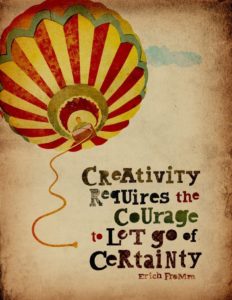 We often use imprecise terms when dealing with vocal anatomy. The one that tends to concern me the most is the phrase, “Voice Box”. It summons up thoughts of “The Little Mermaid” – all your sounds being stored in a little box in your throat, which can be stolen or damaged, thus rendering you voiceless.
We often use imprecise terms when dealing with vocal anatomy. The one that tends to concern me the most is the phrase, “Voice Box”. It summons up thoughts of “The Little Mermaid” – all your sounds being stored in a little box in your throat, which can be stolen or damaged, thus rendering you voiceless.
The larynx is the correct name for ‘the voice box’, and is made up of a number of fleshy and cartilaginous structures. The vocal cords are part of this, certainly, and do probably the closest to what you think ofwhen you think “voice box”. Air travels between them and makes a noise, which varies according to their movement, which – in turn – is controlled by the muscles through the vagus nerve.
All very complicated, and not actually necessary to understand in order to use them. Like so many things involved in singing, we can do a huge amount with visualisation and exercise to get the direct result we want without having to understand parts of our anatomy over which we have very little direct control.
The main thing when thinking about the larynx during singing is that your throat (and by extension, your larynx) should be relaxed. I often say in vocal lessons that some of the greatest singers are the most relaxed – listen to Dionne Warwick for a masterclass in relaxation in the larynx. She makes it sound easy because it IS easy for her. She has worked very, very hard to make it that easy.
Here are my best tips for singing effortlessly:
- Always warm up before singing. At least 20 minutes, if not more. If you go to a choir, warm up on your way there, don’t just rely on the exercises you do when you get there. Try humming up and down super, super gently whilst you are in the car on your way there. Make sure to rotate your head and stretch out your neck and throat muscles.
- Practice opening your mouth when you sing. I am strongly of the opinion that because our society does not generally prize loud voices, we clamp them down with closed mouths. I’ve lost count of the number of people I’ve seen singing through clamped teeth over the years. It’s terrible for both your muscular control and the sound that you are making. However, the key is this – don’t just open your mouth when you are singing, or you will be making your jaw muscles tense through unusual use as much as if they were clenched shut. Practice talking with an open mouth and singing in front of a mirror to check what is happening with your mouth and jaw.
- Actually, now I think about it, singing in front of a mirror is an excellent thing to do anyway! Formany good reasons (not least of which is how to make yourself look less daft whilst singing), a mirror is a good idea. Things to watch for: your stomach should be inflating when you breathe, not just your chest. Make sure your shoulders are dropped when you sing, not hunched up and stressed. Don’t frown! It’s a lot to think about all at once, but remember that the aim of the game is get all of this stuff into your muscle memory so that you don’t have to think about it, it will just happen.
- When your swallow, feel the front of your throat, your ‘Adam’s Apple’ will bob. This is your larynx. Try to keep it low in your throat. This DOES NOT MEAN forcing it down, which will just make your voice sound a bit strangled. It is more a case that if you feel your throat closing up when you reach for higher notes, give a little thought to your larynx. Lower the back of your tongue and concentrate on letting your Adam’s Apple drop naturally. Relax your throat, even if it means you can’t hit that top note that you are going for. Range can come later – right now you need to be relaxed!
- Experiment with different sounds whilst warming up your voice. Humming is good, (mmmm) but it can make fillings and facial prosthetics vibrate in an alarming fashion! Cycling through the vowels in order is also good. Try pushing your start note higher each time, but continuing with the samenumber of notes, so that you expand the top of your range. Same with pushing your range down. As you hit the top of your range, take a deep breath and try to keep the note held and pure with as little tonal drift or vibrato as possible. With that long held note, concentrate on relaxing everything and dropping your larynx without forcing it down.
Give all of that a go! Let me know how you get on…
 It’s been an odd few months here at Community Choir Towers…. Lots has changed, and that’s putting it mildly.
It’s been an odd few months here at Community Choir Towers…. Lots has changed, and that’s putting it mildly. Well, this is going to be a cheery post, isn’t it?
Well, this is going to be a cheery post, isn’t it? For most beginning singers, the volume of their voice is something that bothers them almost as much as how in tune they are. I’ve lost track of how many times I have stood in front of a group of new singers and asked them to reproduce a note, and hear them enthusiastically sing back a variety of wrong notes, then ask them to do the same exercise again, but quietly, and hear 95% of them hit the note accurately.
For most beginning singers, the volume of their voice is something that bothers them almost as much as how in tune they are. I’ve lost track of how many times I have stood in front of a group of new singers and asked them to reproduce a note, and hear them enthusiastically sing back a variety of wrong notes, then ask them to do the same exercise again, but quietly, and hear 95% of them hit the note accurately.
 There are many things in this life that irritate me to the point of… well, maybe not violence, but certainly a heartfelt “GRRRRR!” under my breath and stalking away to put the kettle on. Bullying, racism, being rude to waiters…. And first and foremost: people who think that if they can’t hit a note reliably from the age of 3 or 4, then they are ‘tone deaf’ and should never be allowed to sing.
There are many things in this life that irritate me to the point of… well, maybe not violence, but certainly a heartfelt “GRRRRR!” under my breath and stalking away to put the kettle on. Bullying, racism, being rude to waiters…. And first and foremost: people who think that if they can’t hit a note reliably from the age of 3 or 4, then they are ‘tone deaf’ and should never be allowed to sing. Apologies for not blogging over the Christmas and New Year period – things were very busy here at Bishop Grosseteste University with all of the Community Choir events and then a little bit of relaxation and unwinding after what has been a bit of a challenging year.
Apologies for not blogging over the Christmas and New Year period – things were very busy here at Bishop Grosseteste University with all of the Community Choir events and then a little bit of relaxation and unwinding after what has been a bit of a challenging year. The past couple of months have been taken up partly by a break from work over the summer (although it was a bit of a busman’s holiday this year, as it involved accompanying my husband to festivals for a lot of the summer) and before that – by a huge show that my community choirs were asked to do for the BBC –
The past couple of months have been taken up partly by a break from work over the summer (although it was a bit of a busman’s holiday this year, as it involved accompanying my husband to festivals for a lot of the summer) and before that – by a huge show that my community choirs were asked to do for the BBC –  of performing in public – some
of performing in public – some I was recently passed a clipping about a fascinating study being undertaken by Tenovus Cancer Care. They are a charity providing support to cancer patients and funding lots of different research.
I was recently passed a clipping about a fascinating study being undertaken by Tenovus Cancer Care. They are a charity providing support to cancer patients and funding lots of different research.